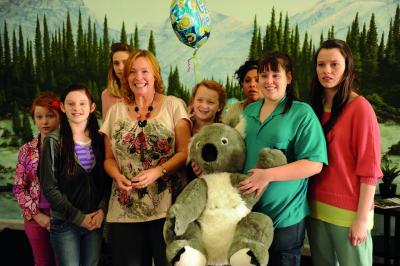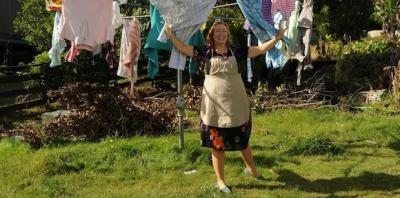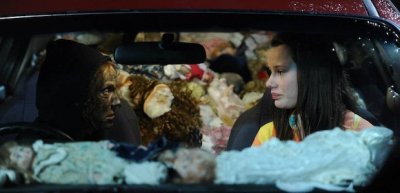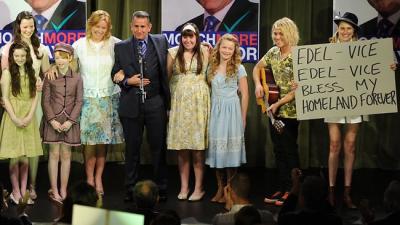By: debbie lynn elias
PJ Hogan never disappoints with his films, especially his comedy. Be it My Best Friend’s Wedding or Confessions of a Shopaholic or even the poignancy of Peter Pan, I know I’m in for a good time with Hogan at the helm, and with MENTAL he had me at the opening strains of The Sound of Music. Yes, the hills of Australia are alive with The Sound of Music.
As he did with Muriel‘s Wedding, Hogan draws on his own family and real life experiences to bring us one of his patented quirky Australian spins, this time on the issue of mental illness and the fracturing of a family. Believing laughter to be the best medicine, Hogan delivers plenty of that thanks to well-written characters and dialogue, heavy infusion of pop culture and, of course, music, not to mention the chameleonic and charismatic Toni Collette.

The Moochmores are not your typical family. Dad, Barry, is mayor of Dolphins Head and spends little, if any, time at home with wife Shirley and their five daughters. In fact, Barry spends so little time at home, he doesn’t even know his daughters’ names. As for Shirley, she has withdrawn into the world of The Sound of Music, wanting nothing more than for the Moochmores to be the Von Trapps. And in true Rodgers & Hammerstein fashion, breaks into The Sound of Music soundtrack at the drop of a laundry basket. When Shirley completely snaps a la a shopping spree that boasts delivery of merchandise from every curtain, door and window on The Price Is Right or Letfs Make A Deal, and with his re-election looming, Barry sends her away “on holiday” aka tosses her in the looney bin. Left alone and unable to deal with his daughters on any level, Barry picks up a hitchhiker named Shaz, ensconcing her as the family nanny. But Shaz isn’t like anyone youfve ever met. A foul-mouthed Mad Hatter-meets-Mary Poppins with a very uniquely eccentric view of life (not to mention a 12 inch hunting knife slid into her boot), Shaz is beyond mental! But it’s that kind of “mental” that puts the world and life into perspective for the Moochmore girls and Shirley.
As Shaz, Toni Collette relishes the role and makes it her own, delivering deliciousness every step of the way. Bold, brassy and brash, Shaz is a character we all want in our lives but for many, are a bit frightened to welcome her in. Collette navigates that sea of trepidation by tempering the kookiness of Shaz with controlled calm and existential insight and by the halfway point, has one so invested in Shaz that you canft imagine your life without her in it.

But as fabulous as Toni Collette is, not to be overlooked by any means is Rebecca Gibney. Her Shirley is the embarrassing mother we all think we have, some may have, and others thank God they don’t have. But Gibney adds a standout texture to the character – she’s not just a mom or a neglected wife, she’s a woman with feelings who just wants to be loved and appreciated.
Similarly, some of the greatest comedic fodder comes compliments of prim, prissy, proper and completely insane neighbors and relatives, Kerry Fox’s Nancy and Caroline Goodall’s Doris. (One, a germaphobe scrubbing the driveway with a toothbrush. Another, obsessed with creating perfect porcelain dolls and treating them like perfect children.)
The Moochmore girls are all divine, starting with Lily Sullivan’s Coral. A dead ringer for a young Geena Davis, Sullivan shines and captures every nuance of teenaged angst and frustration – with herself, her siblings, her parents, her peers. Perfection!

Known for his ability to capture accents, Liev Schreiber amazes with Aussie purity! If I didn’t know it was Schreiber, I would have guessed this was a native Australian in the role of shark-hunter Trevor. For Hogan, an Aussie accent is everything in a “quintessential Australian part”. “As I started talking to Liev, I realized that Liev wouldn’t even consider the part if he didn’t think he could do the accent. And he’ brilliant at accents. The Australian accent is extraordinarily difficult so anytime an Australian director casts an American. . .it’s a huge roll of the dice. But I rolled the dice because it was Liev and he nailed it.” Gotta love the he-man, masculinity and mystery that he brings to the character. Particularly engaging are scenes between Schreiber and Sullivan where Trevor serves as her employer at his water park/shark tank exhibit. You feel a great connection and almost paternal bond between them that adds a level of sweetness to the dynamic and character structure. However, as good as Schreiber is with Sullivan, critical to the film was his ability to go toe-to-toe with Toni Collette. As Hogan puts it, “I had to have someone really great in that part because Toni is used to wiping actors off the screen. She met her equal with Liev.”
As Barry Moochmore, Anthony LaPaglia is a scream with deadpan befuddlement. So entertaining, one would like to see more of him, however, Hogan judiciously tempered the role as to have more Mayor Moochmore on screen would have adversely impacted the story since one of the major tines in the family dynamic is dad’s absence.
Written and directed by PJ Hogan, with the opening frame of Donald McAlpine’s stunning aerial camera pan of Australia and first strains of The Sound of Music overture, one is hooked. Diving right in with a middle-aged woman plugged into an iPod and mimicking Julie Andrews’ hilltop extravaganza (but in front of the backyard clothesline), the laughter and smiles begin. And showing off his directorial gift for pacing, just when you think you can’t take any more laughter, Hogan backs off, let’s you catch your breath and reveals the heart of the story, the true dysfunction of the family dynamic and the world. Showing us the world through the eyes of Shaz, our eyes are opened along with those of the wannabe Von Trapps.

Not wanting any mis-steps and wanting accuracy with the medical aspects of the story, “I researched every facet of mental illness before I made this film because I didn’t want to get anything wrong.”
Key to the story is that although we’re laughing, we’re not laughing AT the Moochmores. We’re laughing WITH them. Their “fish out of water” dynamic is one that resonates with everyone, whether we admit it about ourselves or not. Who hasn’t felt at sometime in their life like one of the Moochmores or Shaz or even Trevor? Making MENTAL more than somewhat autobiographical, Hogan runs the gamut of family driven emotion and taps into something for everyone. “I’ve made an autobiographical film before. My very first film, Muriel‘s Wedding is based on fact. And that was actually a darker film than MENTAL. It’s going back awhile, but it came from a place of great anger whereas MENTAL is a film that is a lot warmer and a lot funnier because I’m in the trenches with mental illness. My sister is schizophrenic. My brother is bipolar and I’m the father of two autistic children. So this is something that’s an issue that’s very important to me. That’s why I made the film as funny as I could and as politically incorrect as I could because being a caregiver to people with mental challenges, I know that if you don’t laugh, you go crazy yourself. I wanted to make it as politically incorrect as possible because I don’t like political correctness, especially in terms of discussing mental illness. . . How do you talk about mental illness without offending people? That above all else, makes this such a standout story.

An added strong suit of MENTAL is the underlying story of Shaz and Trevor, serving as an eye-opener to both the film itself and the audience, and which is a story unto itself. Watching their story unfold both in a comedic manner a la Shaz and an obsessive somber manner a la Trevor, but above all, a united approach to the past, is not only telling, but grippingly moving. Sadly, as much as this plot point adds to the film, the end result also breaks the heart.
The strength and empowerment that Hogan imbues within his characters, carries over to the audience. You feel like you’ve climbed that mountain with Shaz and the girls, that you have solved problems bigger than Maria von Trapp, and like the Von Trapps and the Moochmores, you can have a happy ending – once you’ve climbed that mountain and discovered your inner strength. Survival, joy, happiness mixed with some sorrow, growing pains, laughter and love. The fact that this script comes from Hogan’s own life is why the characters are so real, the predicaments so fun and funny, the stakes so high. “We all have fucked up families! We all have screwed up families. I don’t even know what normal is!”

As Hogan recalls, “Once I left home and I moved to Sydney and I got out there in life, I realized that there is no such thing as normal. It’s like the word “perfection.” It doesn’t exist. It’s a pretend word. I tried to do that in the film. I tried to present a couple of people in the film who are paragons of normal, posters for normal and, in fact, other people constantly refer to them as normal, like the character based on my dad.”
There are no words adequate to describe Donald McAlpine’s cinematography but for beautiful, bright, colorful, upbeat and even a bit mystical and awakening. Interior color palettes are celebratory, quirky and distinctive creating a Moochmore world that is visually upbeat serving to balance the familial dysfunction and individual angst of the characters.

As mentioned, The Sound of Music is a huge thematic element to MENTAL. Not randomly pulled out a hat by Hogan, “My mother’s favorite film is The Sound of Music and that’s why I used clips from The Sound of Music in MENTAL. . . We watched The Sound of Music and my mum, like clockwork, cry in that same scene. I used it in the movie. When Captain von Trapp pulls out the guitar and goes, “Edelweiss, Edelweiss” and all the kids would gather around and start singing Edelweiss in their beautiful voices. And my mum would go, “Why can’t you sing like that?” And what she really wondered was, “Why can’t Dad can’t come home and sing Edelweiss to us all?” He never came home for dinner let alone come home with a guitar and sing. That was why it was important. The Sound of Music is such an idealized family.”
But beyond the necessary inclusion of character affection for The Sound of Music is the music itself, and on a small budget, license fees can be stratospheric. As Hogan recalls, for MENTAL, “We went into it telling [the Estate of Rodgers & Hammerstein] we donft have a lot of money. We sent them the script. And luckily, Ifve made two movies that involved music of very established singer-songwriters, ABBA in Muriel’s Wedding and Burt Bacharach in My Best Friend‘s Wedding, and both those artists did very well out of those movies. So, the Estate of Rodgers & Hammerstein went, ’Okay. He’s crazy but he’s not insulting. He’s using our music in a respectful way.'”
Heart, humor and hilarity. . .and a BIG hunting knife! It’s great to be “mental” if it means loving MENTAL!
Written and Directed by PJ Hogan
Cast: Toni Collette, Liev Schreiber, Anthony LaPaglia, Rebecca Gibney











